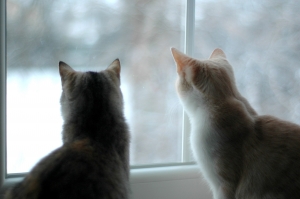
San Diego, CA – So what does a Medium Sulphur-Crested Eleanora Cockatoo do in it’s spare time (of which it has plenty?)
Dance to the Backstreet Boys, is what. That’s right, Snowball, loves to dance to songs with a catchy beat. And this is a scientific breakthrough.
Since October 2007, over 4 million views of his video on YouTube (shown below) have not only catapulted Snowball to stardom, but also into the research of neuroscientists, John Iversen and Ani Patel, who have actively researched the relationship between music and the brain. No one had ever documented an animal processing and reacting to the beat of music, and Snowball was a gold mine of information.
In an interview with the New York Times in May 2010, Patel described the significance of the finding, “Before I encountered Snowball, I wondered whether human music had been shaped for our brains by evolution — meaning, it helped us survive at some point. Well, in 2008, a colleague asked me to view a YouTube video of a cockatoo who appeared to be dancing to the beat of “Everybody” by the Backstreet Boys! My jaw hit the floor. If you saw a video of a dog reading a newspaper out loud, you’d be pretty impressed, right? To people in the music community, a cockatoo dancing to a beat was like that. This was supposed to be, some said, a uniquely human behavior! If this was real, it meant that the bird might have circuits in its brain for processing beat similar to ours.”
He conducted an experiment with Snowball, “Let’s design an experiment to see if this is real, I proposed to Irena Schulz (the owner), who had a science background herself. We took the Backstreet Boys song, sped it up and slowed it down at 11 different tempos, then videoed what Snowball did to each. For 9 out of the 11 variations, the bird moved to the beat, which meant that he’d processed the music in his brain and his muscles had responded. So now we had the first documented case of a nonhuman animal who, without training, could sense a beat out of music and move to it. ”
Patel explains how this information can be used, “There’s a neurologist in Boston, Gottfried Schlaug, who uses music therapy to return some language to stroke victims. He has them learn simple phrases by singing them. This has proved more effective than having them repeat spoken phrases, the traditional therapy. Schlaug’s work suggests that when the language part of the brain has been damaged, you can sometimes recruit the part that processes music to take over. Music neuroscience is also helping us understand Alzheimer’s. There are Alzheimer’s patients who cannot remember their spouse. But they can remember every word of a song they learned as a kid. By studying this, we’re learning about how memory works.”
As for Snowball, he continues to make music videos and post them on YouTube. He has successfully brought attention to bird rescues like Bird Lovers Only Rescue Service, which caters to abandoned birds like Snowball. These interesting birds have much to teach us.





